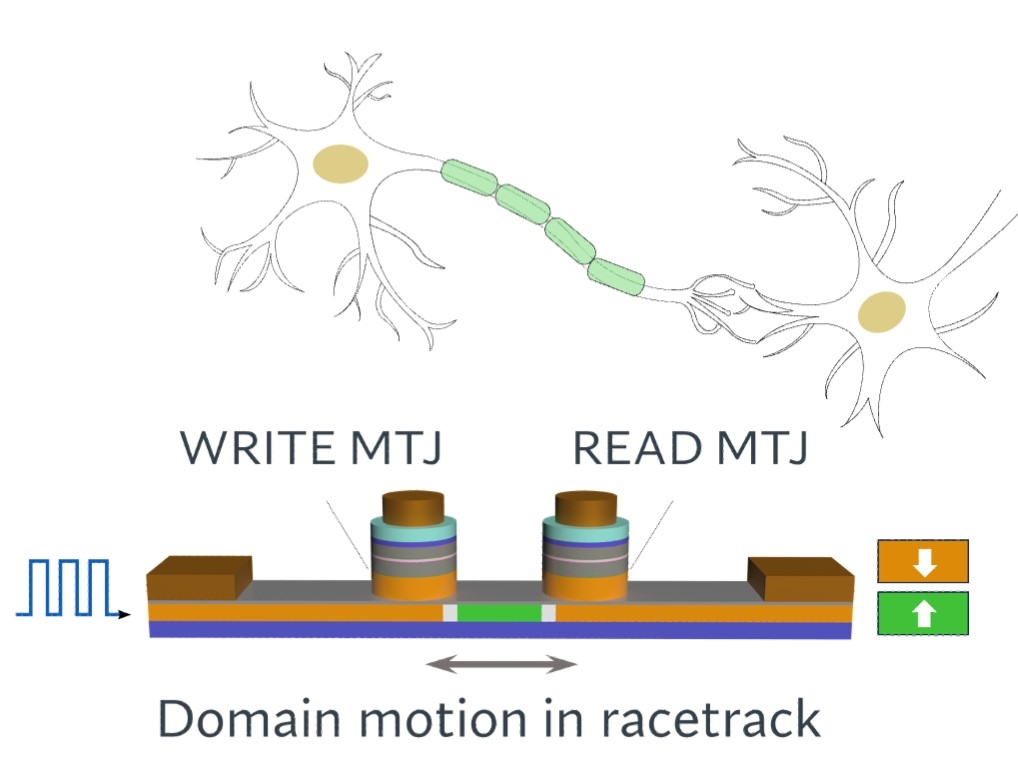Magnets Emulate Neurons for Next-Generation Computing
In the quest to bring the next evolution of computing to the masses — electronics that can think like the human brain — researchers from The University of Texas at Austin have achieved several key milestones.
In recent discoveries, Texas Engineers have developed artificial neurons — the messenger cells that send signals from the organism’s brain to the body — made of magnetic materials. They’ve done so in a way that they can control these artificial neurons with more precision and with a longer life cycle than anything that has come before, further advancing the field of neuromorphic computing.

Magnet-based neurons (below) can make many of the functions of natural neurons (above)
“By adjusting the physical properties of these devices, we’ve unlocked the potential for them to display diverse, reliable and adaptable neuron behaviors,” said Jean Anne Incorvia, associate professor in the Chandra Family Department of Electrical and Computer Engineering and the principal investigator of a pair of recently published papers. “This combined tunability and reliability is crucial for the future of neuromorphic computing.”
The Research: The first paper, published in ACS Nano, focuses on controlling spintronic devices, which use magnetic domain walls and magnetic tunnel junctions to perform neurons’ messaging jobs. The devices demonstrated “leaky-integrate-and-fire” behavior. That involves integrating the incoming signals over time, firing to deliver those messages, and leaking to reset back to a resting state for receiving more information.
The other paper, published in Nano Letters, focuses on reliable operation of these neurons over many cycles. The researchers created a device that can perform all the essential duties of a neuron over 100 continuous cycles with no loss of performance.
“The inability to achieve consistent and reliable operation over many cycles has been a major roadblock for magnetic material-based neuromorphic computing,” said Can Cui, a 2024 Ph.D. graduate who was the lead student on this project and now works at Micron Technology. “We’ve shown that these new, reliable spintronic neurons can match or even outperform ideal theoretical models, which could lead to the development of highly efficient and robust neuromorphic systems.”
Why it Matters: More complex technology, including smarter artificial intelligence systems and autonomous vehicles, demands more powerful and scalable computing systems. The development of neuromorphic devices could enhance computing in many ways.
It could lead to a more efficient alternative to energy-hungry transistors, making electronics generally more efficient, especially important as AI energy costs continue to skyrocket. Consistent performance over the long term means our phones, laptops, and other electronics could last longer. Better decision making could improve self-driving cars that have to constantly make split-second calls and make AI systems better at image recognition, natural language processing and other tasks.
In the larger quest to recreate the human brain’s processing power, most of the focus has been on artificial synapses, the structures that determine the connectivity of neurons. Neurons have proven more challenging to construct, but the researchers managed to do so on a single device.
Up next, the researchers are working to scale up their technologies. In recent months, they received support from the Cockrell School and Discovery to Impact, UT’s commercialization team.
The Team and More: The ACS Nano research was funded through a collaboration with Sandia National Laboratories. The team includes Christopher Bennett of Sandia and Thomas Leonard, Nicholas Zogbi, Samuel Liu and William S. Rogers of the Chandra Family Department of Electrical and Computer Engineering. Liu and Jaesuk Kwon, both from electrical and computer engineering, joined Incorvia and Cui on the Nano Letters paper, which was funded through Incorvia’s NSF CAREER Award.
